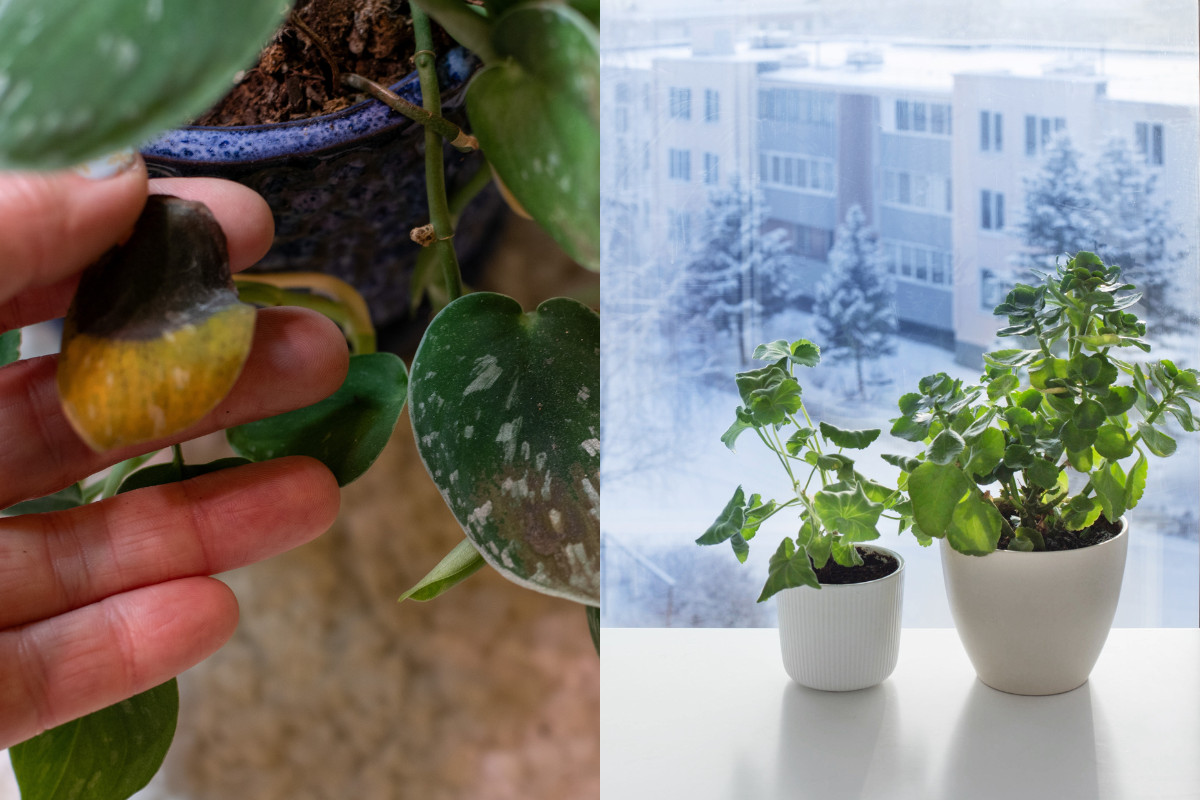

When the darkish nights attract and the winter months start in earnest, my favourite factor to do is get cozy on the sofa and take a well-deserved break. It’s the right time on your houseplants to have a pleasant relaxation, too.
However with the intention to make that occur, there are a number of adjustments you’ll want to make to your ordinary plant care routine.
The most important focus is on water and air. Whereas most houseplants are ready to deal with the lower in gentle in the course of the winter, there’s a hazard that overwatering can lead to root rot. The dry central-heated air that fills our houses can play havoc with moisture-loving vegetation, too.
All of this leads as much as wintertime being probably the most lethal time of 12 months for houseplants.
Bear in mind, many vegetation enter a interval of dormancy over the winter and received’t produce new progress to preserve vitality. Their wants are fairly totally different throughout this chilly, darkish season.
The purpose is to maintain your houseplants joyful in order that, come springtime, they bounce again into a brand new rising season.
I’ve handled dropped leaves, spindly stems and etiolated branches over earlier winters. Now, I’ve put collectively a few of my hard-won suggestions and methods to take care of your houseplants this winter season. Take every tip with a grain of salt, and make sure you analysis the wants of your vegetation earlier than using them.
1. Compensate for the lower in winter daylight
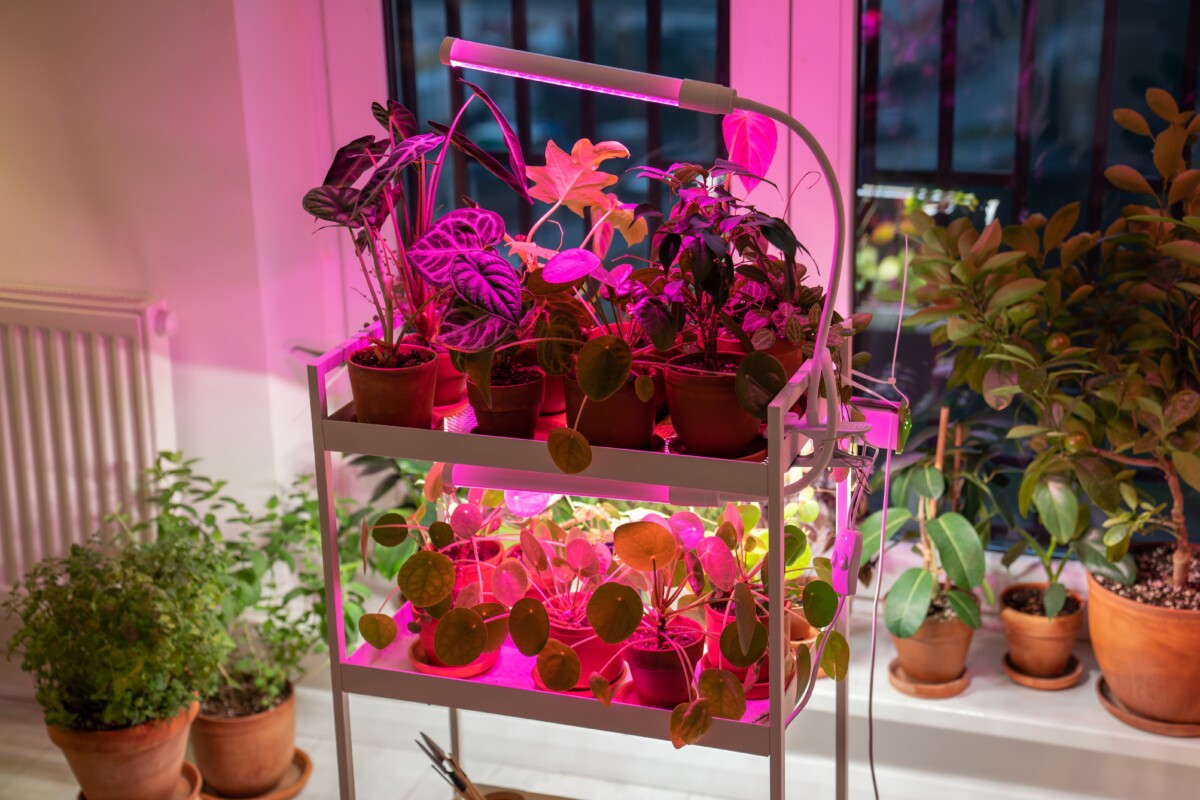
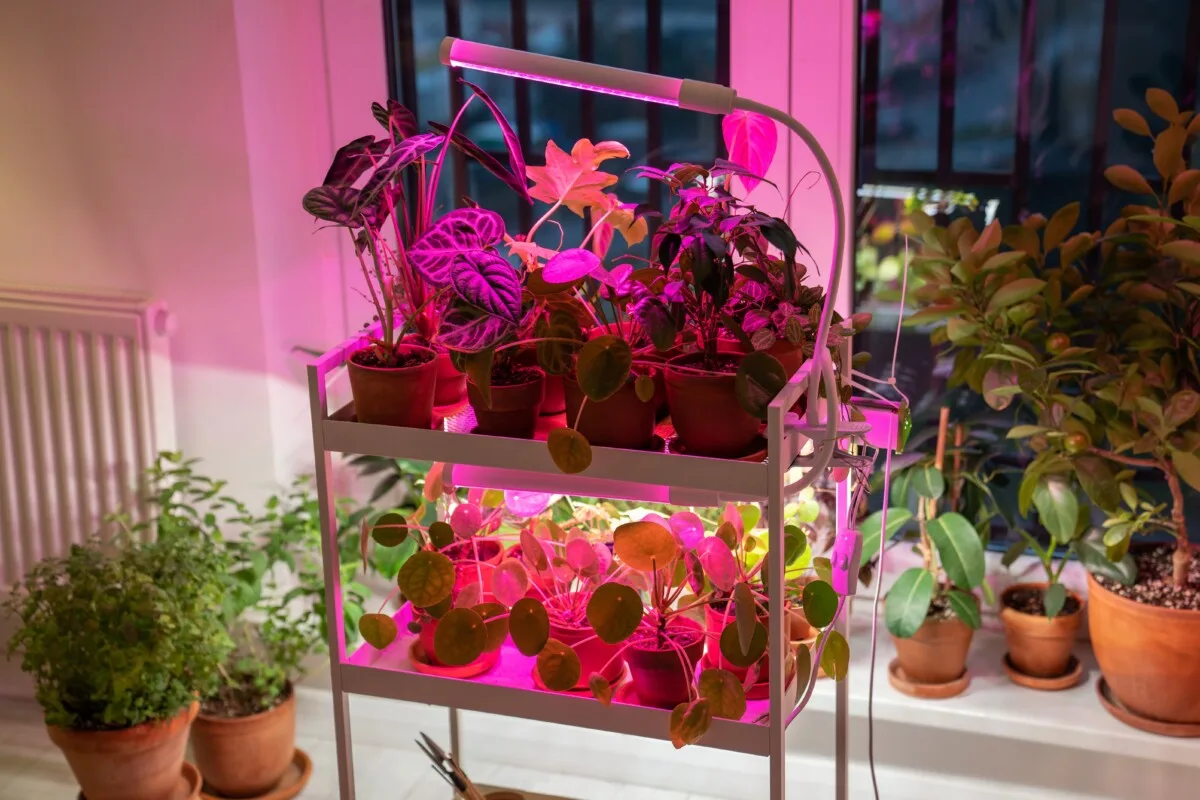
With fewer daylight, a plant’s ordinary location in your house won’t obtain sufficient pure gentle in the course of the winter. Transferring your light-loving vegetation like crotons and monsteras nearer to home windows – south going through if potential – will assist on this occasion. As well as, rotate every plant each week so all sides get an equal quantity of sunshine. Take this chance to present your home windows a fast clear, too, because it makes it simpler for gentle to get in.


In case your window house is proscribed, investing in a transportable develop gentle could make all of the distinction. You possibly can place your vegetation in no matter location you want at dwelling, whatever the pure gentle out there.
Alternatively, you possibly can change a few of your common gentle bulbs with full-spectrum lights.
Whereas they appear virtually indistinguishable from regular lights to us, these bulbs cowl extra pink and blue wavelengths and will help with plant progress because of this – simply preserve them on for at least 6-7 hours a day to reap the advantages. As a bonus, full-spectrum lights additionally assist with Seasonal Affective Dysfunction.
2. Cut back your common watering schedule
One of many best and most vital adjustments to make in the course of the winter is to the watering schedule.
Due to the winter dormancy that almost all houseplants expertise, you possibly can afford to drastically minimize down on watering – rule of thumb is simply watering each two weeks at a minimal. As an alternative of adhering to a schedule, although, test the plant itself for its water wants.
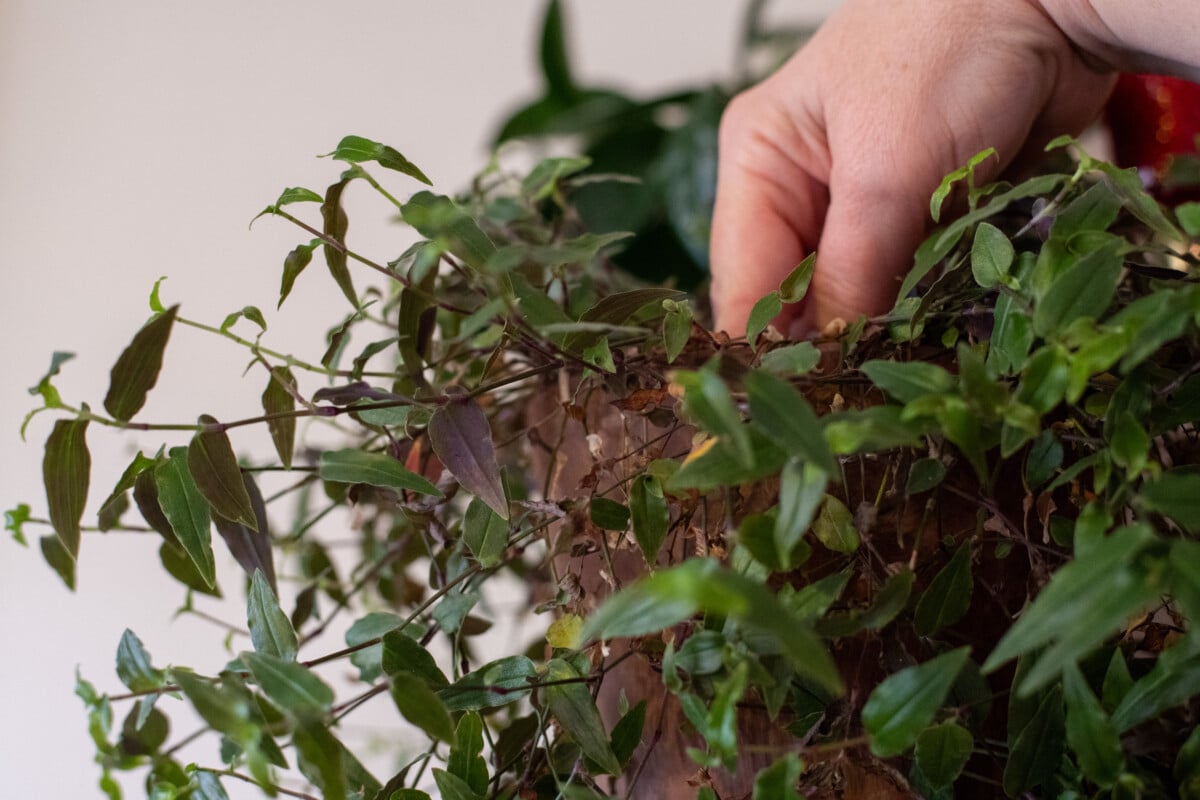
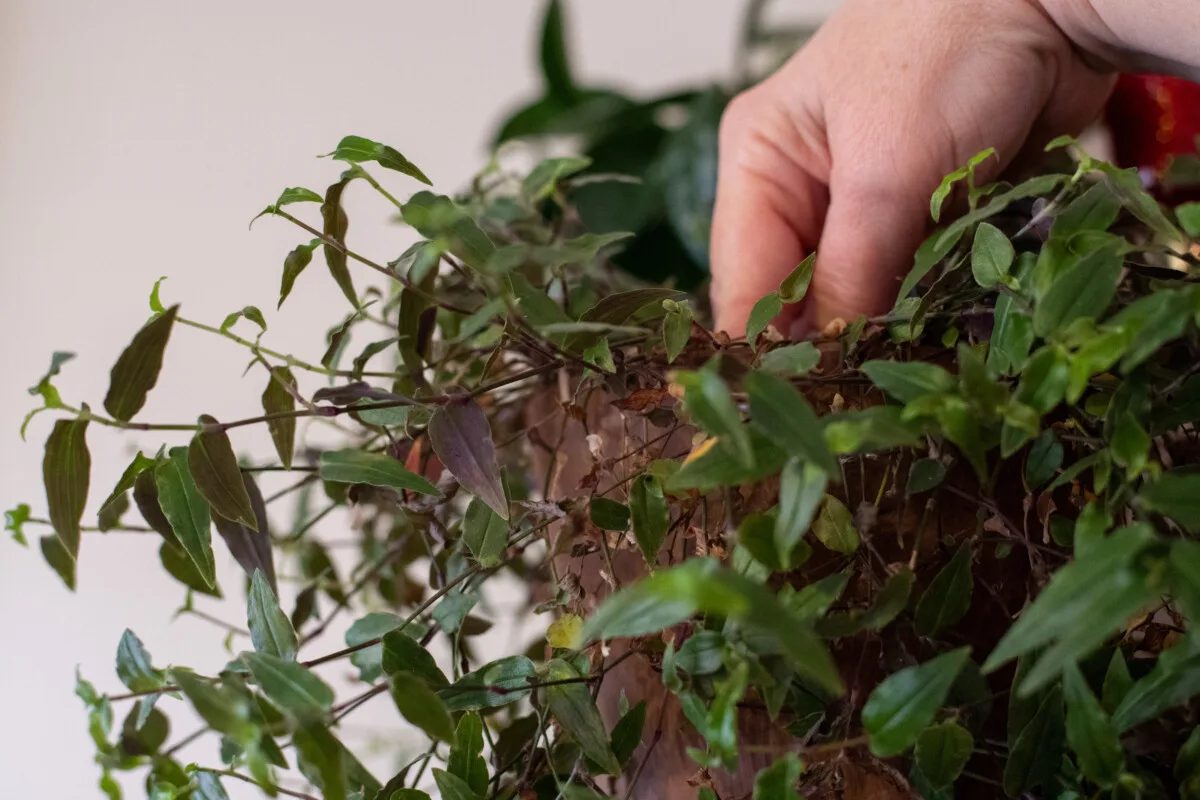
Earlier than watering in winter, notice the dryness of the soil by checking the highest two inches with the tip of your finger. If it’s utterly dry, you can provide the plant a drink; if the soil remains to be moist, then wait a number of days earlier than checking once more.
Helpfully, some vegetation will provide you with a warning to their watering wants: a peace lily will nonetheless droop when it’s thirsty, and a spider plant’s leaves will get paler and fewer buoyant. For succulents that like a dry atmosphere, even in the summertime, you possibly can in the reduction of to each three weeks or extra. You possibly can cease watering cacti completely till the winter is over.
When unsure, water even lower than ordinary. It’s a lot simpler to rectify a thirsty-looking plant within the winter than desperately making an attempt to reverse any root rot that’s set in.
However watch out. Whereas yellow leaves and brown leaf suggestions is likely to be extra widespread within the winter, surprisingly, they’re not normally the results of a thirsty plant.
Associated studying: The intelligent immediate repair for brown recommendations on any houseplant (and find out how to cease it occurring once more)
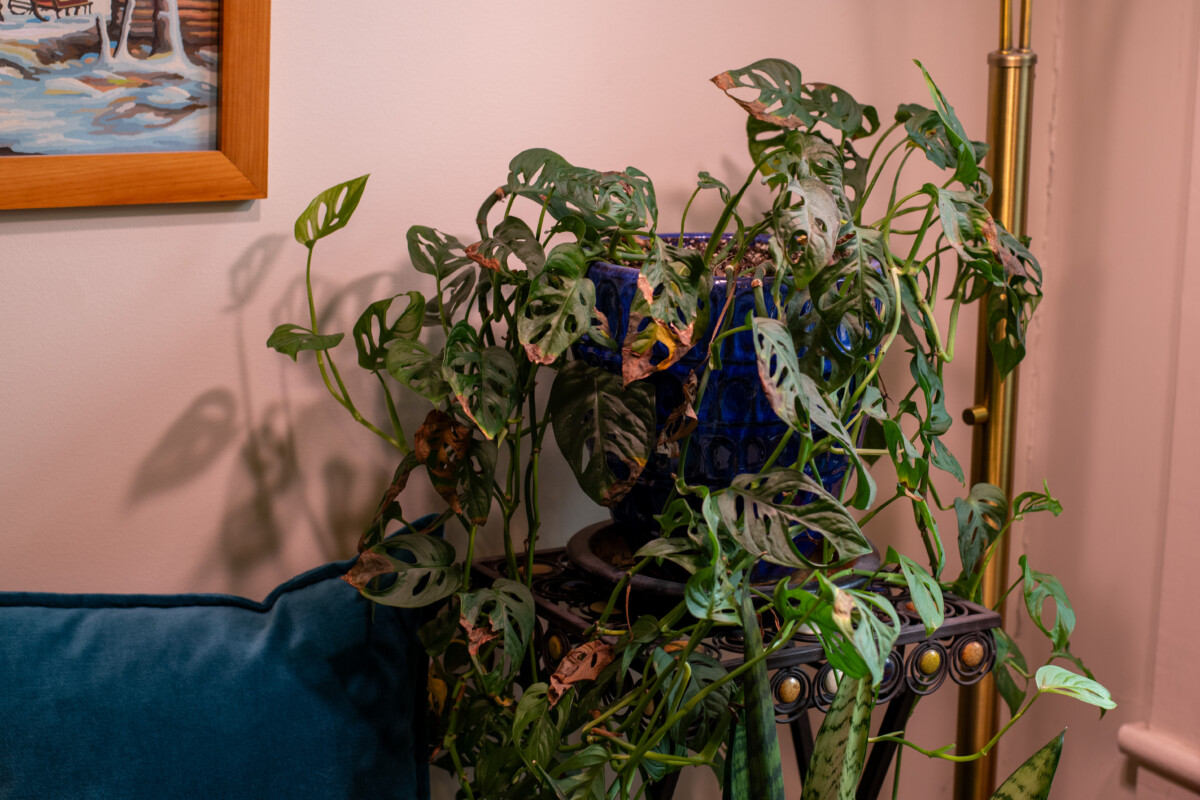
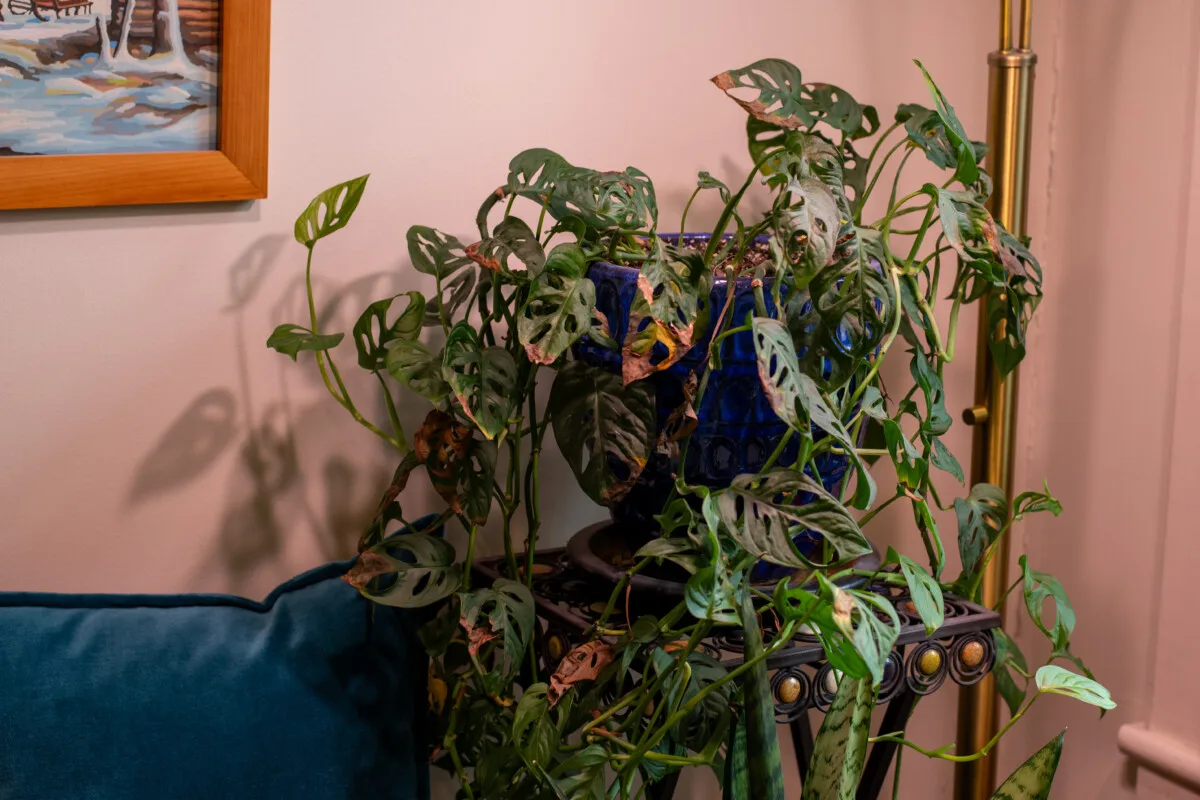
Our editor, Tracey, has a poor Monstera adansonii affected by some wintertime overwatering. Oops!
It’s additionally a good suggestion to test the temperature of the water earlier than watering, as chilly water can significantly shock the roots. Goal for room-temperature water to maintain wintering vegetation joyful.
3. Control indoor humidity ranges
Indoor humidity sometimes reduces within the winter after we activate radiators and central heating. As most indoor vegetation are tropical, they like a humidity stage of 30% to 40%. Step one is to maintain vegetation away from direct sources of dry air and warmth.
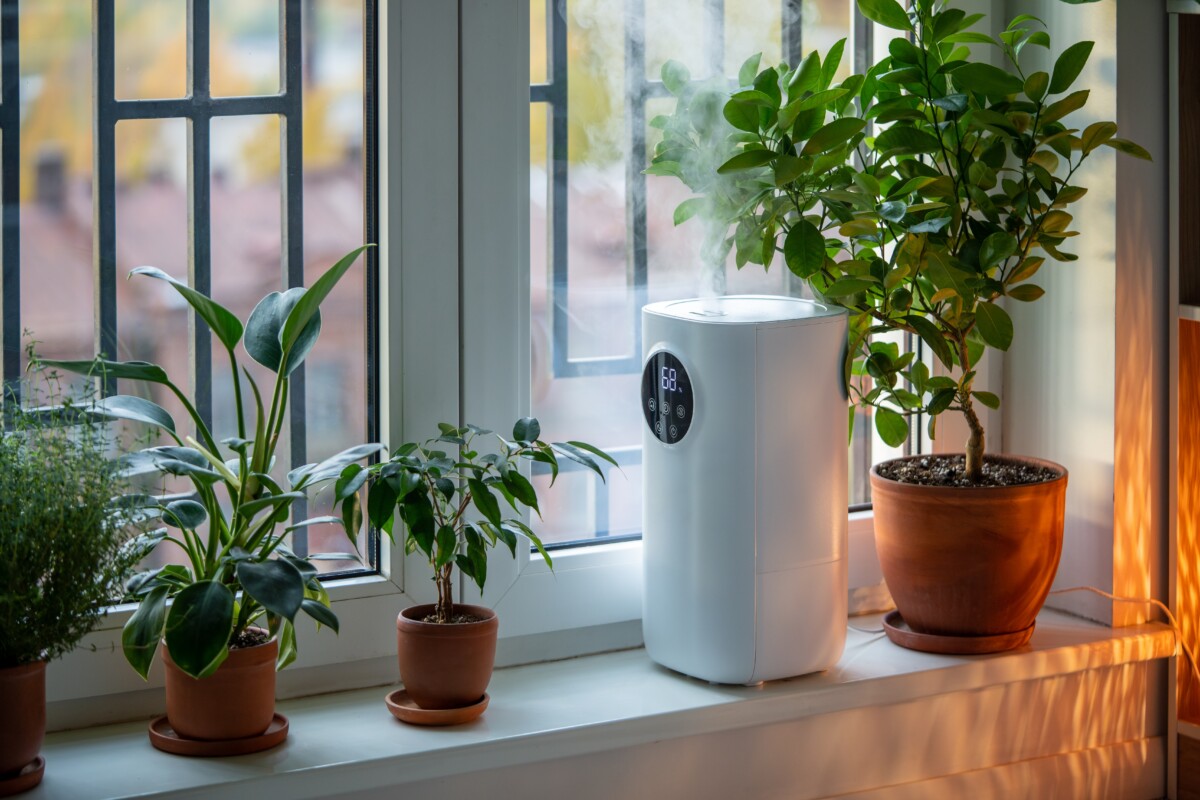
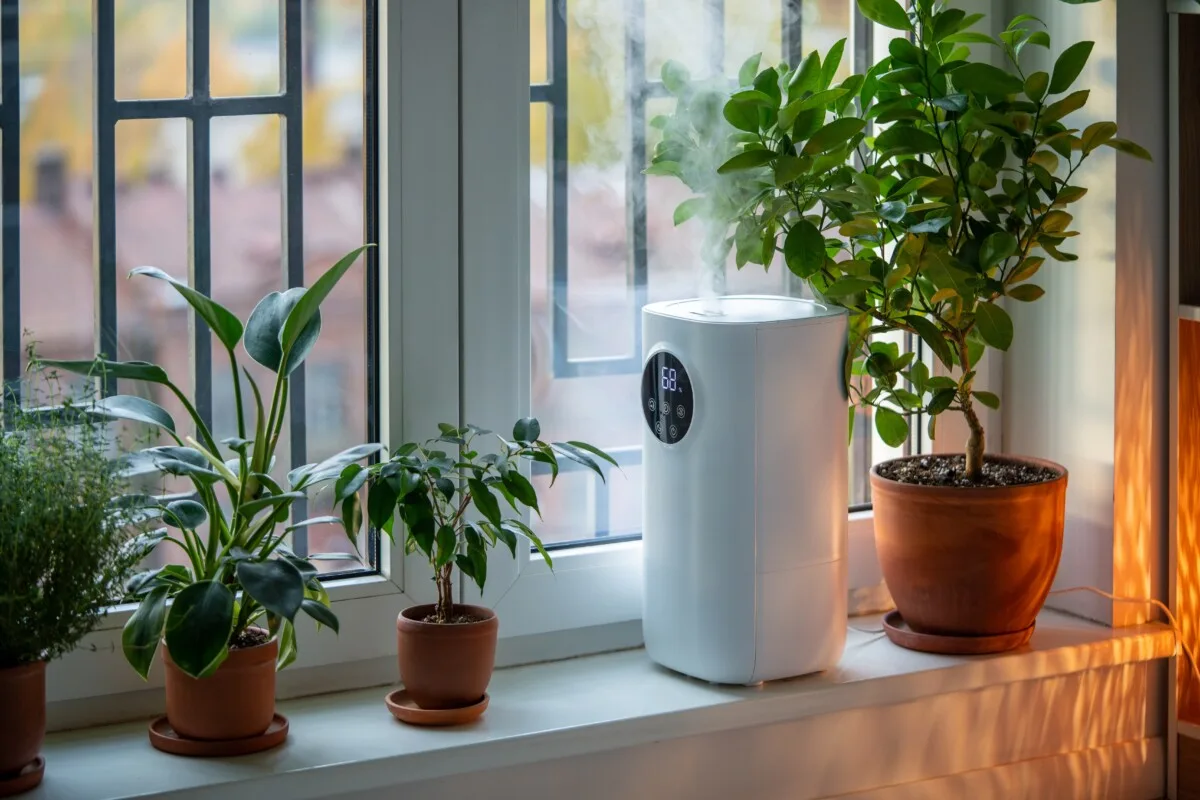
Misting with distilled water can add some moisture to the air. Organising a small humidifier can be a good suggestion. Choosing a smaller measurement means you’re not including extra humidity to your own home general, which may result in a rise in dampness throughout winter.
4. Shield your vegetation from chilly drafts
Fluctuating temperatures are the bane of winter plant care. Houseplants desire to be at temperatures of 65-75F and are prone to undergo if temperatures fall under 60F.
Which means sweeping your house for drafty home windows, doorways, and any significantly chilly spots. Don’t overlook concerning the temperature of the window glass itself, which is normally fairly frosty to the contact – not good for any far-reaching leaves. Both make the most of insulation to dam drafts in these spots or, higher but, guarantee your vegetation are stored nowhere close to.
After all, it’s a little bit of an issue when a drafty window can be the most effective place on your houseplants to obtain much-desired daylight.
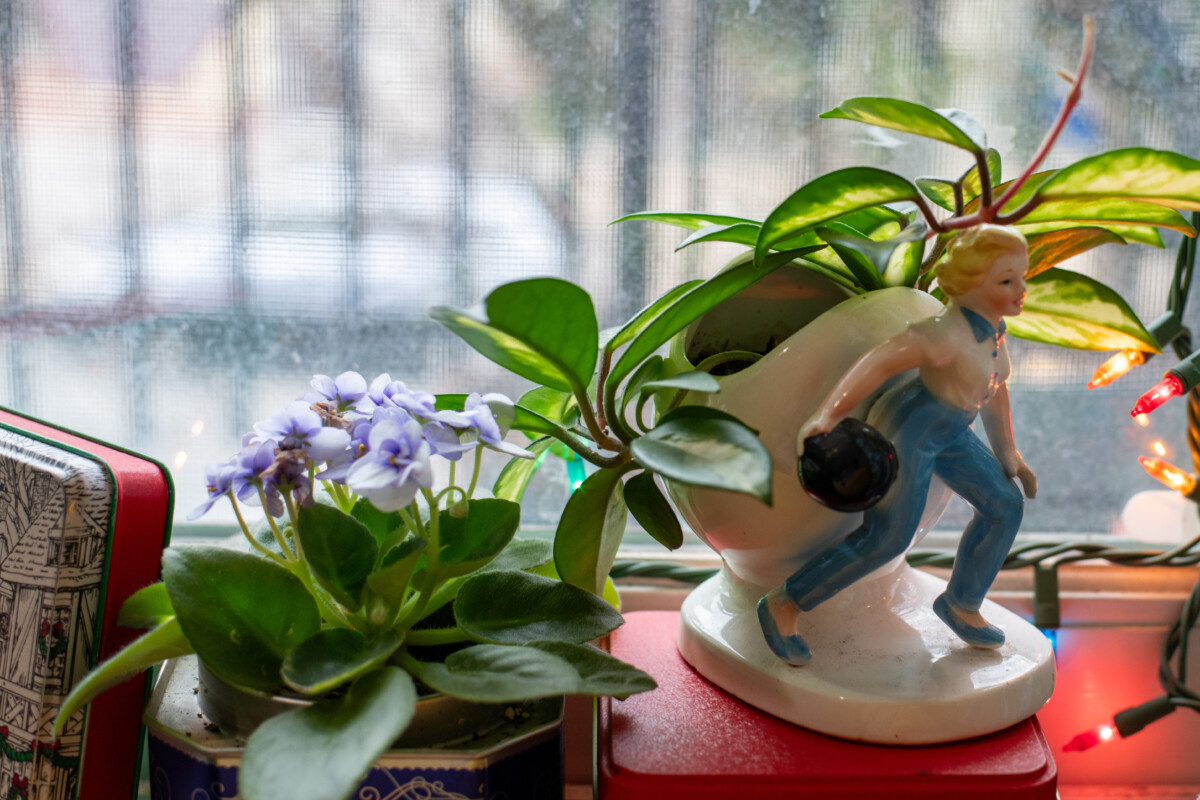
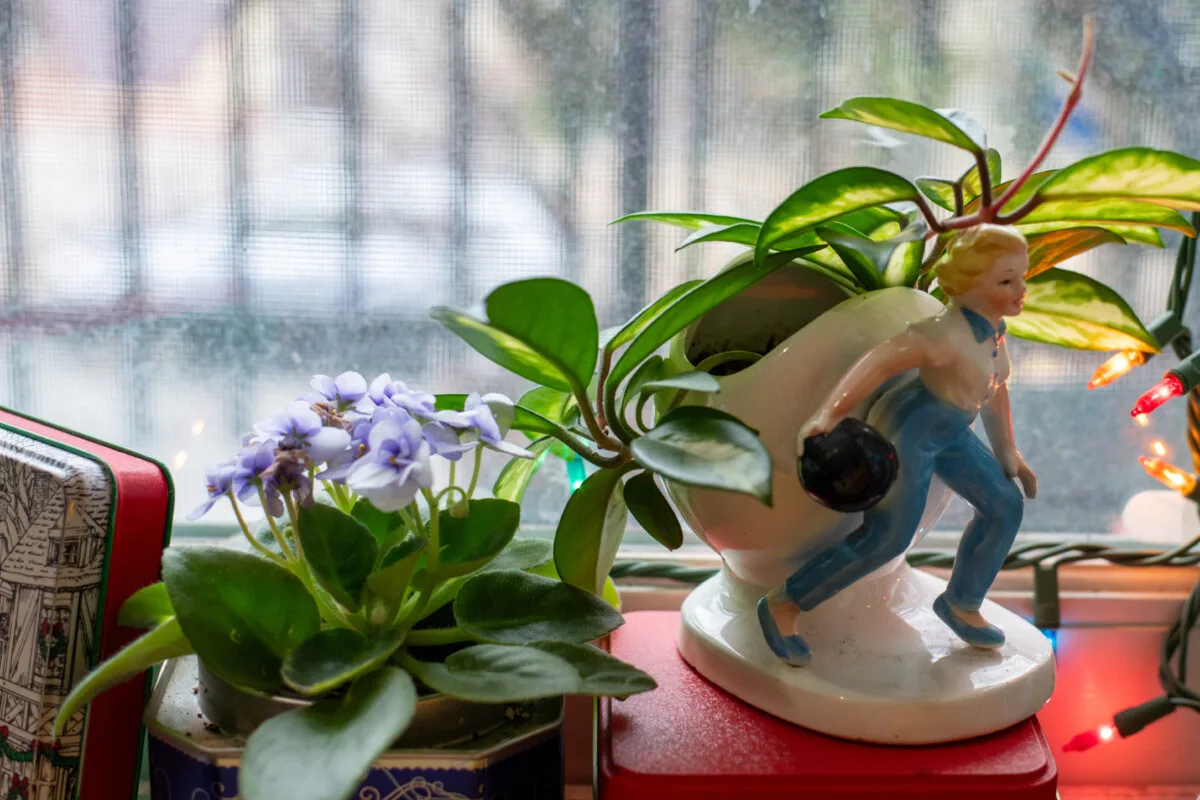
If it’s important to put vegetation near a window, be certain the leaves aren’t touching the glass, and switch them as soon as per week.
For individuals who are houseplant-obsessed, it’s definitely potential to maneuver vegetation away from home windows every afternoon as soon as the sunshine has pale and the air grows colder. Alternatively – and likewise for probably the most cold-intolerant vegetation – you possibly can attempt establishing slightly micro-climate to maintain them joyful. A small house with a warming mat, develop lamps, and a tray of water-covered pebbles for some added humidity will do wonders.
5. Don’t fear if there’s no new progress
Most houseplants received’t produce new leaves or foliage over the winter, so don’t be alarmed if a once-bushy summer time plant all of a sudden stops displaying any progress. It means the plant is focusing vitality on nourishing the roots and leaves it already has.
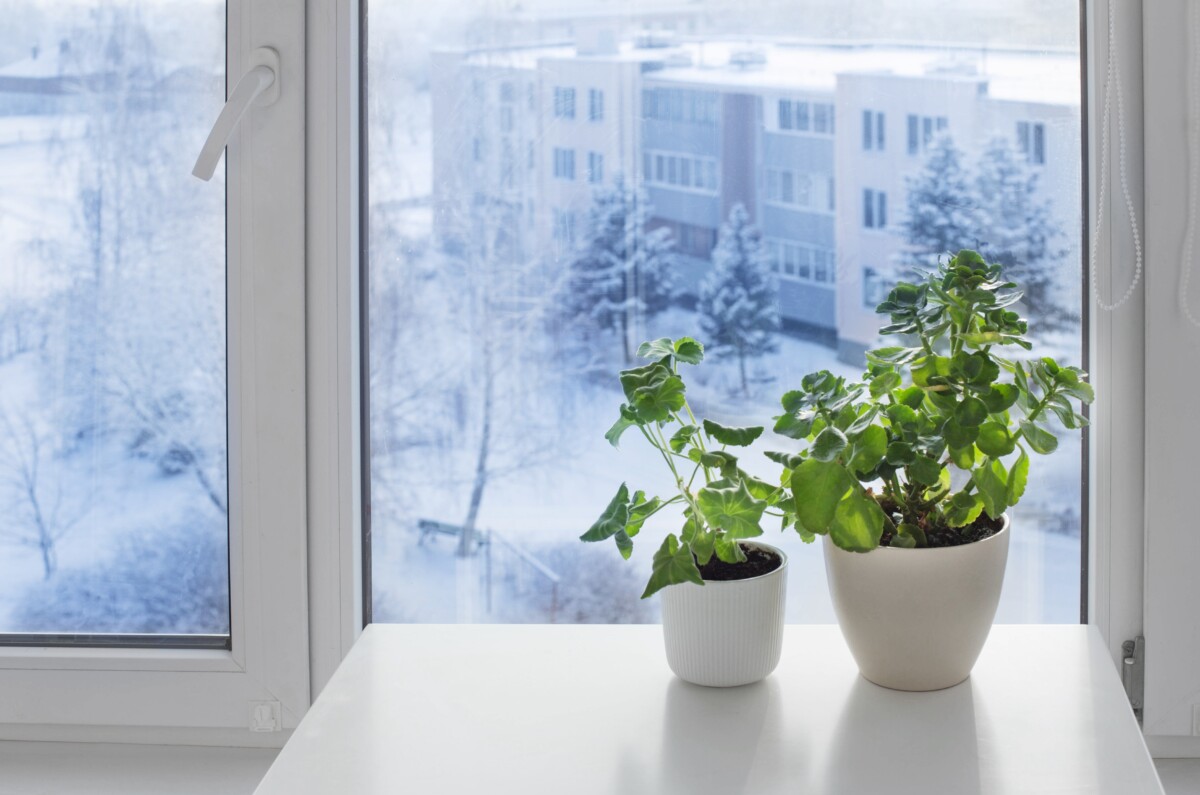
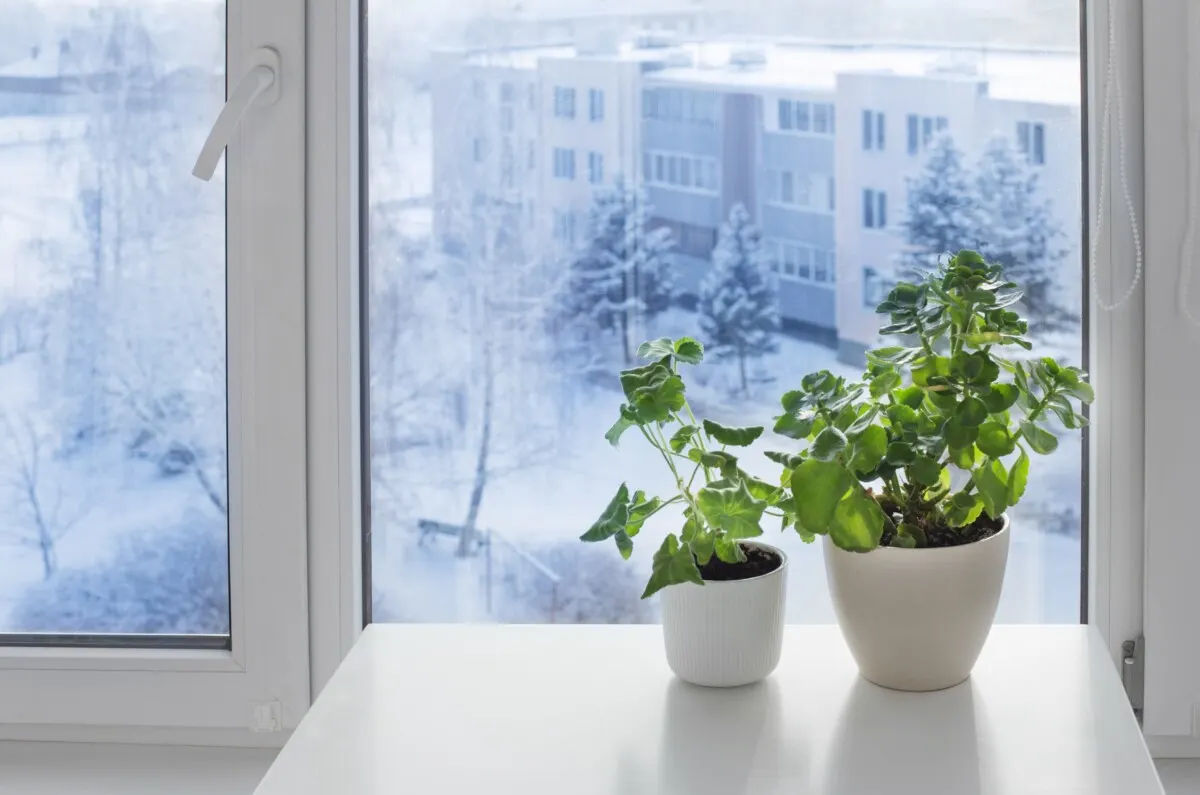
That doesn’t imply all of your houseplants are dormant, although. In actual fact, the hotter your indoor atmosphere stays, the much less seemingly vegetation will go dormant within the winter. As such, they nonetheless want water and light-weight to maintain them going.
6. Keep away from doing any repotting (particularly with dormant vegetation)
Drop that pot and put your trowel down. Although it could not seem to be it at first look, repotting a plant will be fairly aggravating at any time of 12 months – however in winter, you’re successfully stunning the plant at a time when it’s not actively rising. It’s additionally extra seemingly that the recent compost will keep moist for longer, which might doubtlessly harm the roots.
If you happen to completely should repot, be sure the plant is stored heat afterward by utilizing a warmth mat and maybe a develop gentle too.
Repotting vs. Potting Up
Potting up a houseplant (i.e. once you merely add the plant, soil and all, right into a barely larger pot) is totally different from repotting (when all of the previous soil is faraway from the foundation ball and changed with new soil). Potting up is much less stunning, so it’s far more amenable within the winter.
7. Clear mud out of your plant’s leaves
Simply because your houseplants are dormant and resting over winter doesn’t imply they’re not in want of some basic care or repairs. In actual fact, the winter season is an ideal time to wash the leaves: it helps vegetation to profit from the decrease gentle ranges, helps to discourage pests, and improves their general look too.
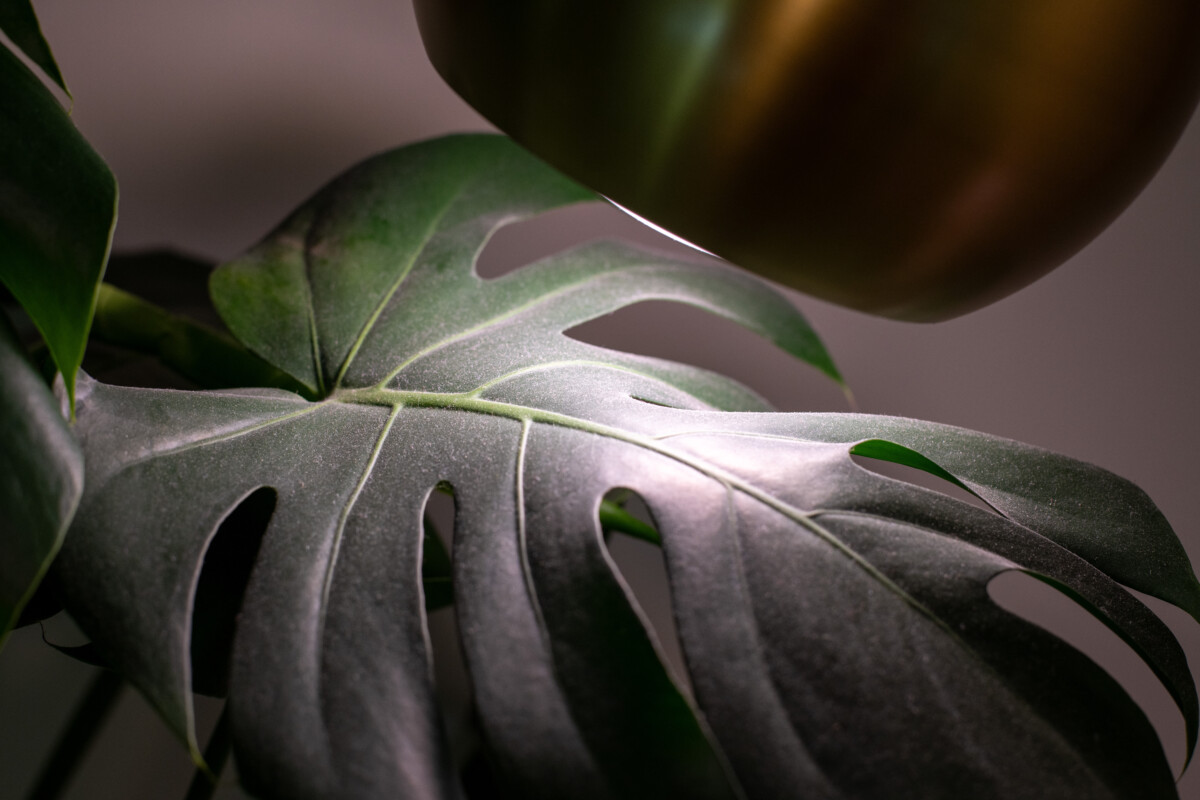
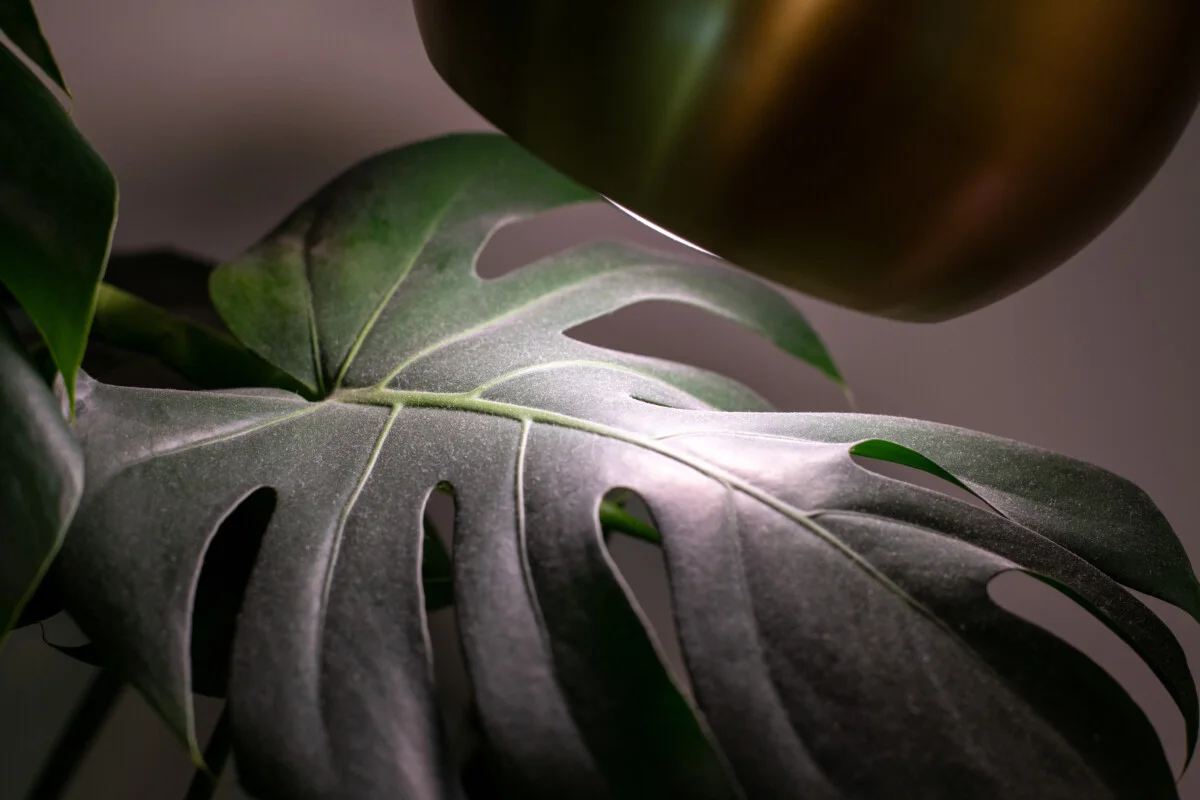
Crops typically entice grime and dirt, increase a basic residue of stickiness that impacts their means to soak up daylight and photosynthesize. If you happen to can really feel a layer of mud once you rub the leaves, then it’s time to wash them.
Cleansing your houseplant’s leaves is a straightforward venture: Merely take a material or paper towel dampened with heat water and gently wipe the floor of every leaf. Ensure to help every leaf from beneath to keep away from breaking the stems, and don’t use a scratchy sponge or material, as these can harm the leaf tissue.
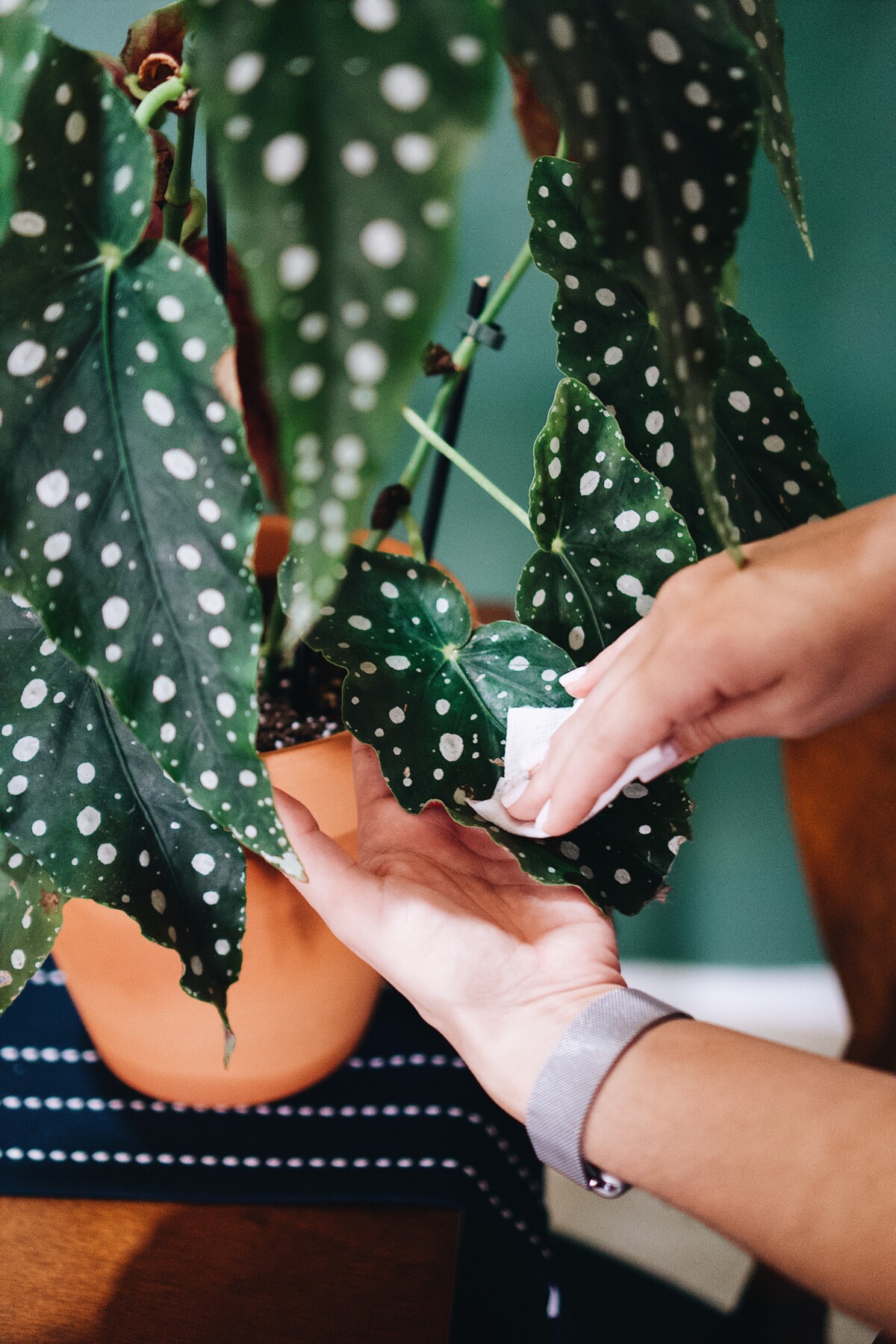
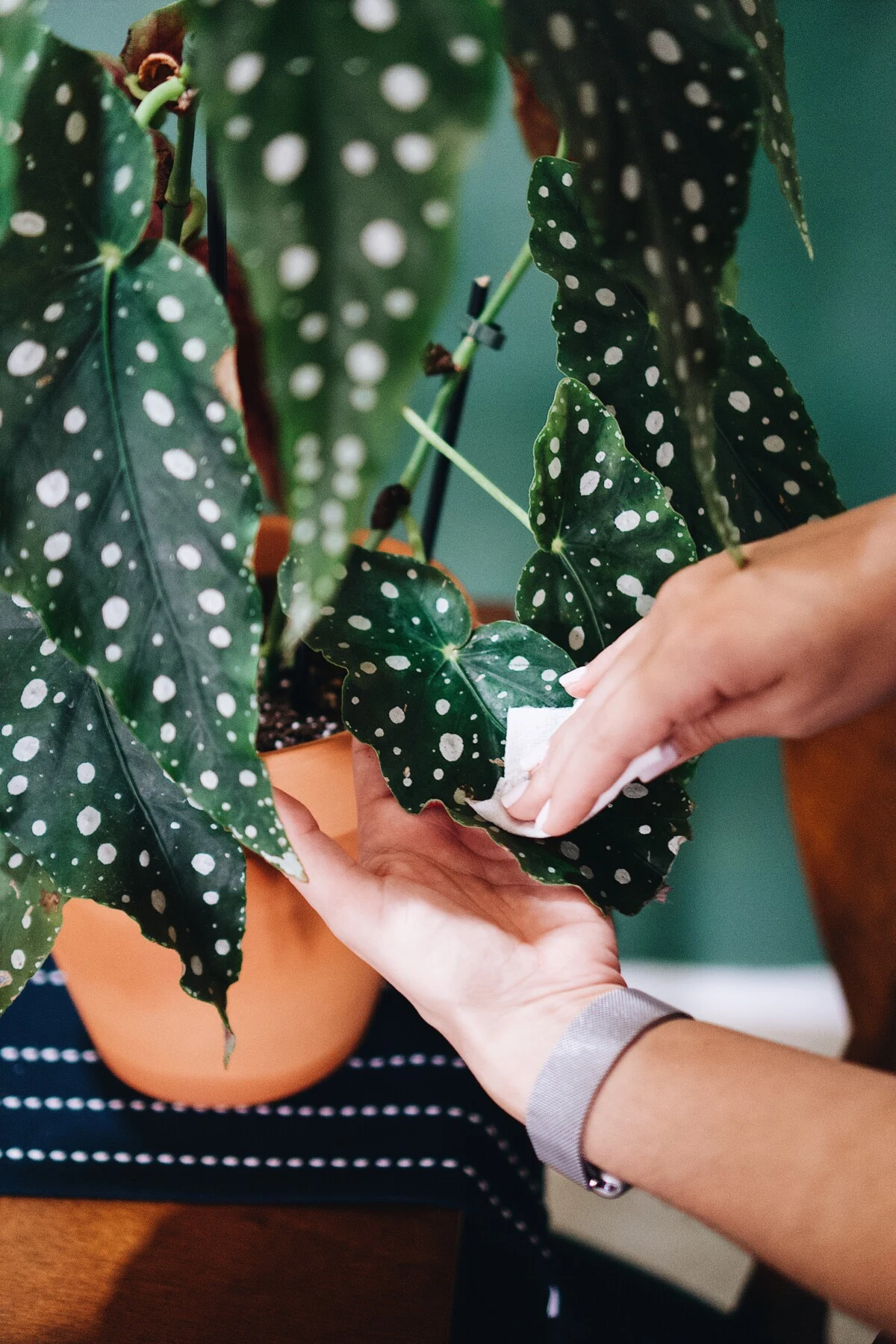
Extra delicate and feathery vegetation are slightly trickier to wash (maidenhair ferns, I’m taking a look at you). You need to use a paintbrush, a cotton pad, and even Q suggestions. Alternatively, utilizing a misting bottle to spray the leaves can obtain a lot of the cleansing course of with out truly needing to the touch every leaf.
For significantly tall vegetation which might be onerous to succeed in, utilizing a feather duster for the uppermost leaves can be a helpful trick.
8. Prune and tidy up
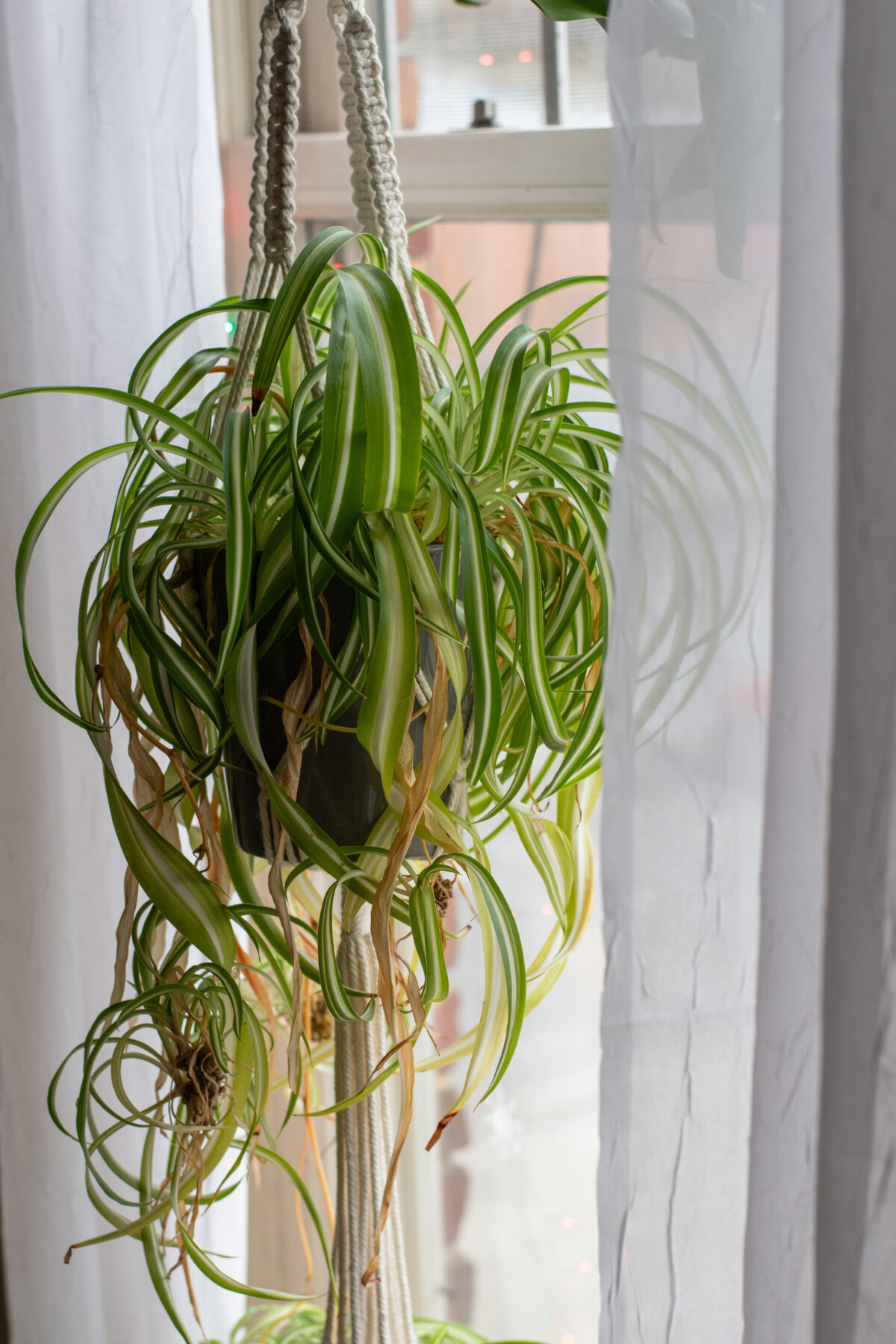
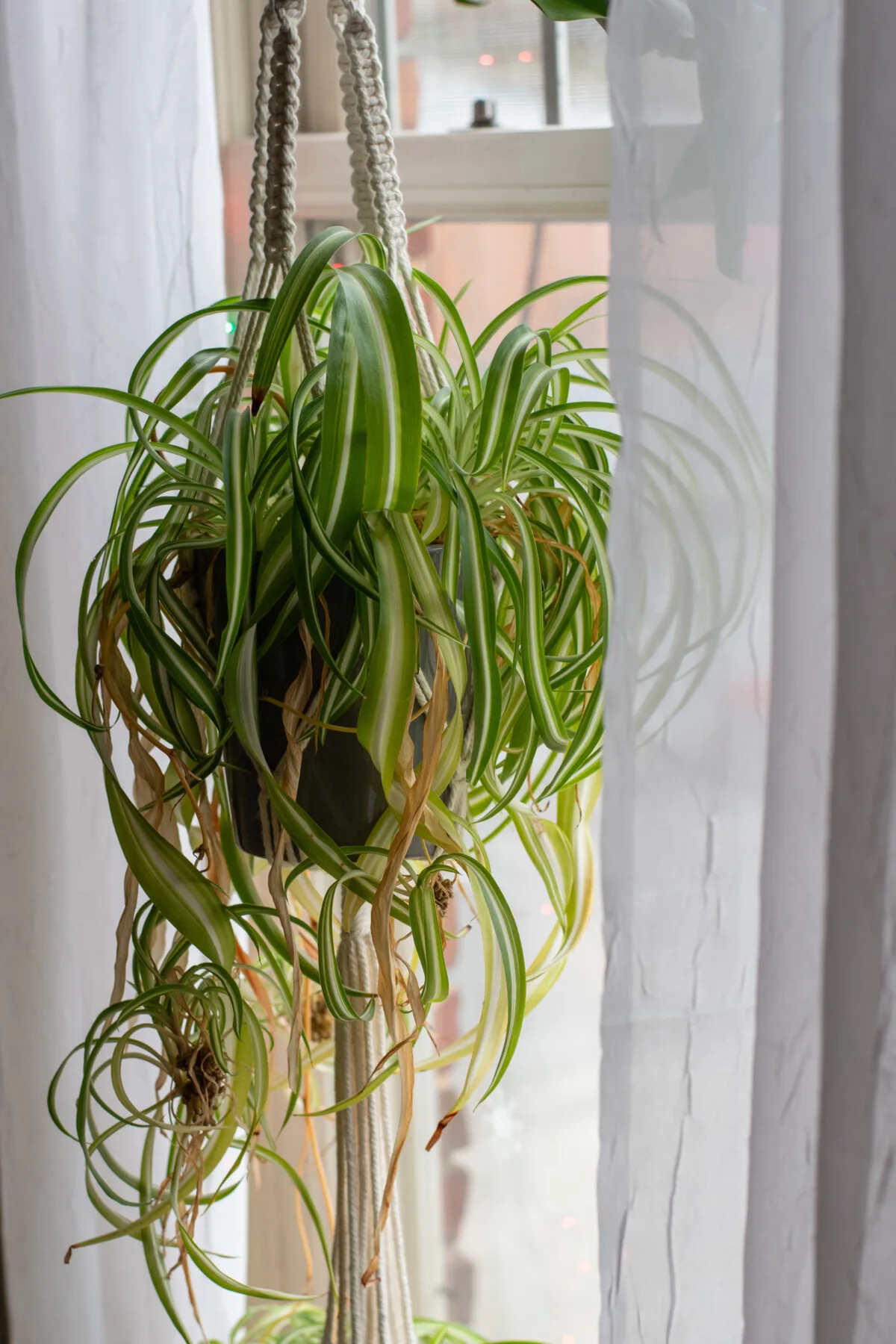
This spider plant may use slightly sprucing up.
Together with cleansing your plant’s leaves, why not do some tidying up too? A houseplant shall be losing vitality on any deadened branches and dying leaves, so slicing again these crispy bits will each enhance the plant’s look and preserve it more healthy.
An added bonus of pruning in winter is you could nonetheless expertise a little bit of plant magic by propagating. Pothos and pilea vegetation are hardy sufficient to develop over winter, they usually’ll be prepared for potting up within the spring. You would additionally use slightly rooting hormone on the propped cuttings to encourage them to place out roots.
9. Don’t fertilize or feed houseplants within the winter
Fertilizer is an integral a part of houseplant care within the hotter months. Fertilizing whereas vegetation are dormant will be damaging and result in fertilizer burn. That’s as a result of whereas vegetation are dormant, they’ve fewer nutrient wants.
Avoid your ordinary fertilizer choices till the hotter months, and your vegetation will thanks.
10. Be vigilant for bugs and pests
Sadly, a comfortable, heat atmosphere is the right breeding floor for plant pests to thrive. We’re speaking thrips, aphids, fungus gnats and mealy bugs galore. These little fiends multiply rapidly, taking issues from an preliminary situation to an infestation, so it’s of the utmost significance to do away with them quick.
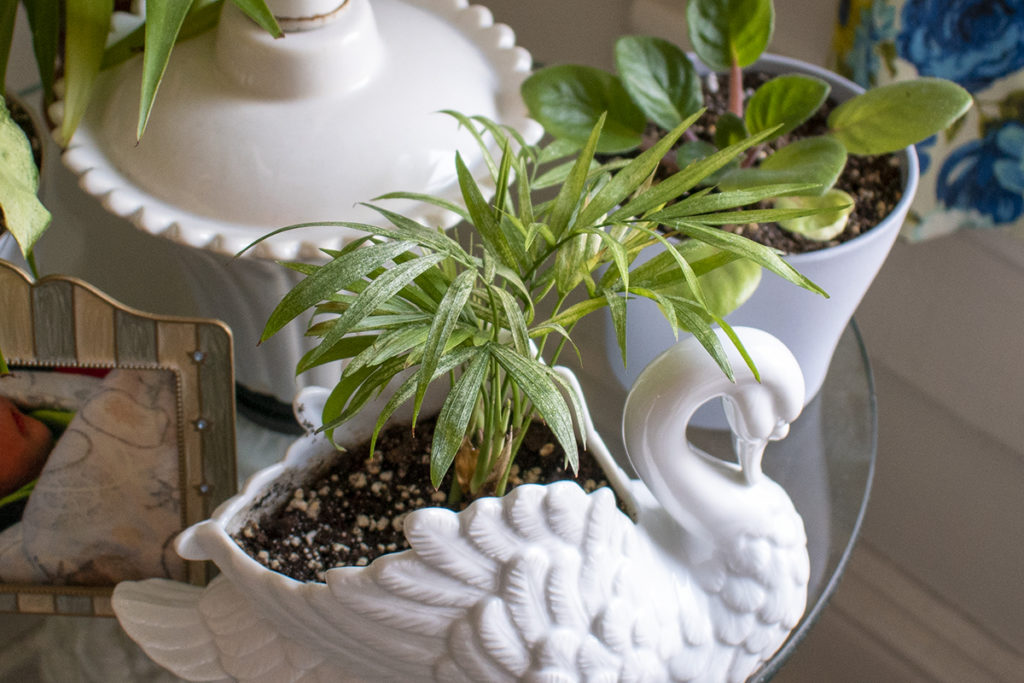
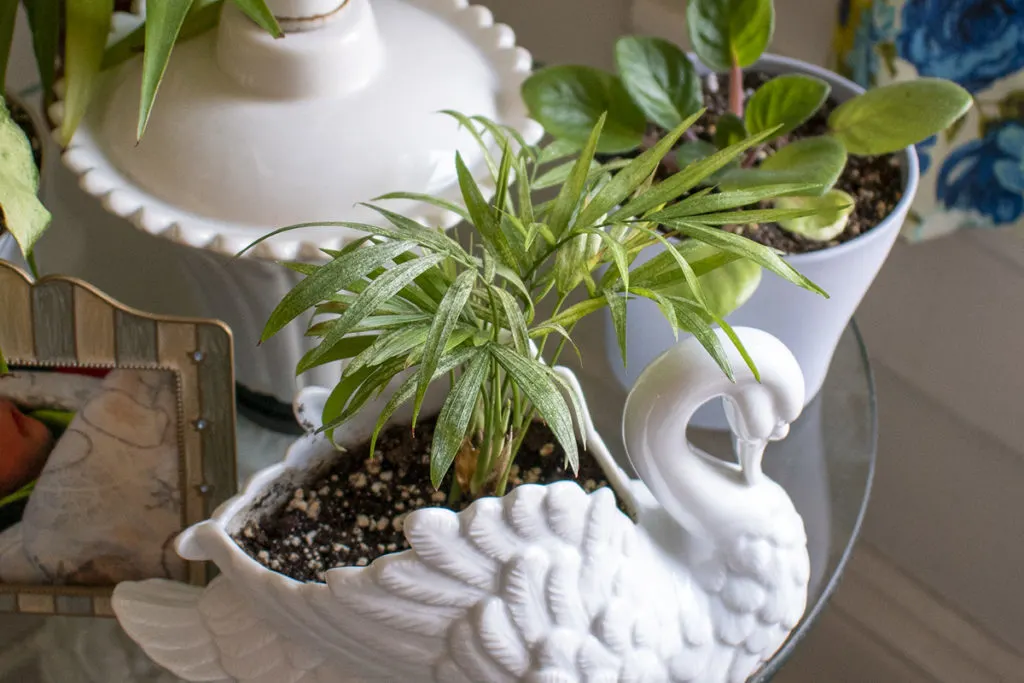
This poor little parlor palm is affected by a spider mite infestation.
Combine a few drops of delicate family liquid cleaning soap in a twig bottle and spray generously. Then, both wipe the incapacitated bugs off along with your fingertips or with a moist material. Remember to examine completely amongst the undersides of leaves and within the crevices of stems, too. These bugs are specialists at hiding.
As a basic rule of thumb, it is best to recurrently examine your vegetation for bugs all year long in order that any potential bug infestations don’t get uncontrolled.
Over the winter, you would possibly see leaves starting to yellow or drop. They may curl up, expertise tip burn or start to shrivel. Whereas all these signs could really feel like trigger for alarm, don’t panic! Nearly all of vegetation will undergo a little bit of an adjustment interval and are prone to bounce again.
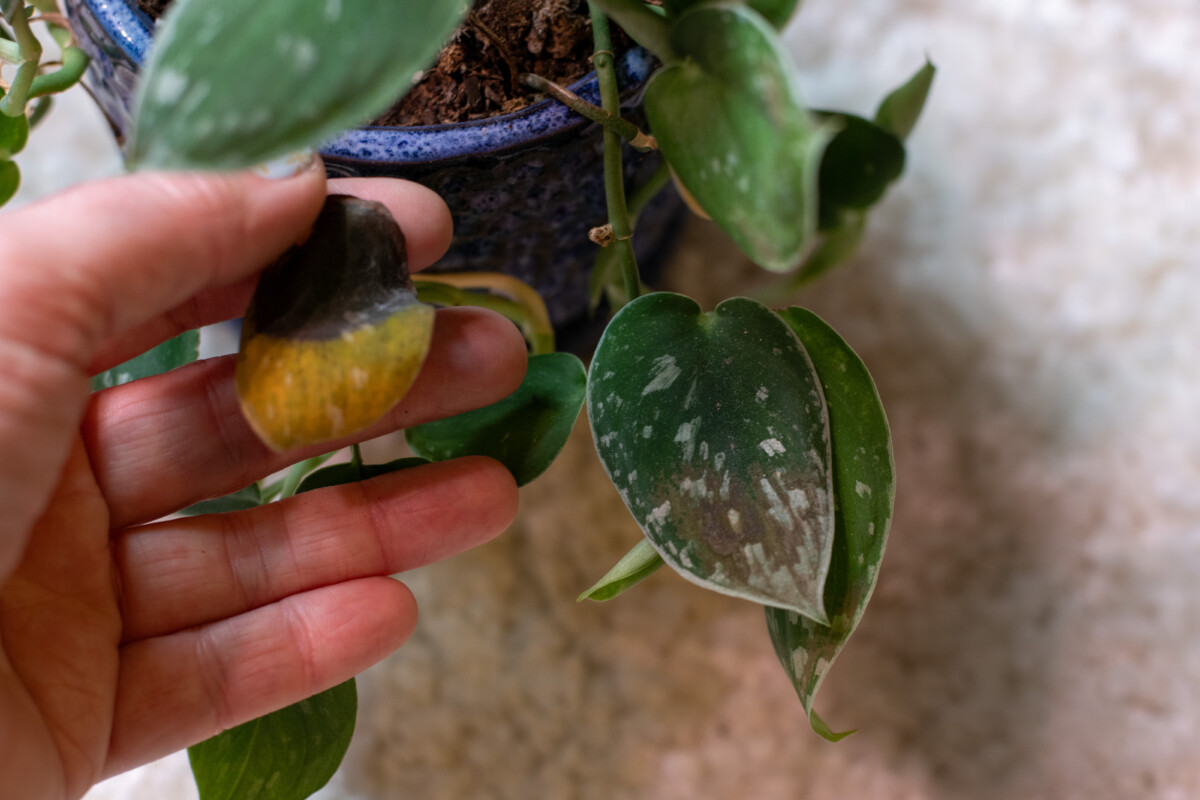
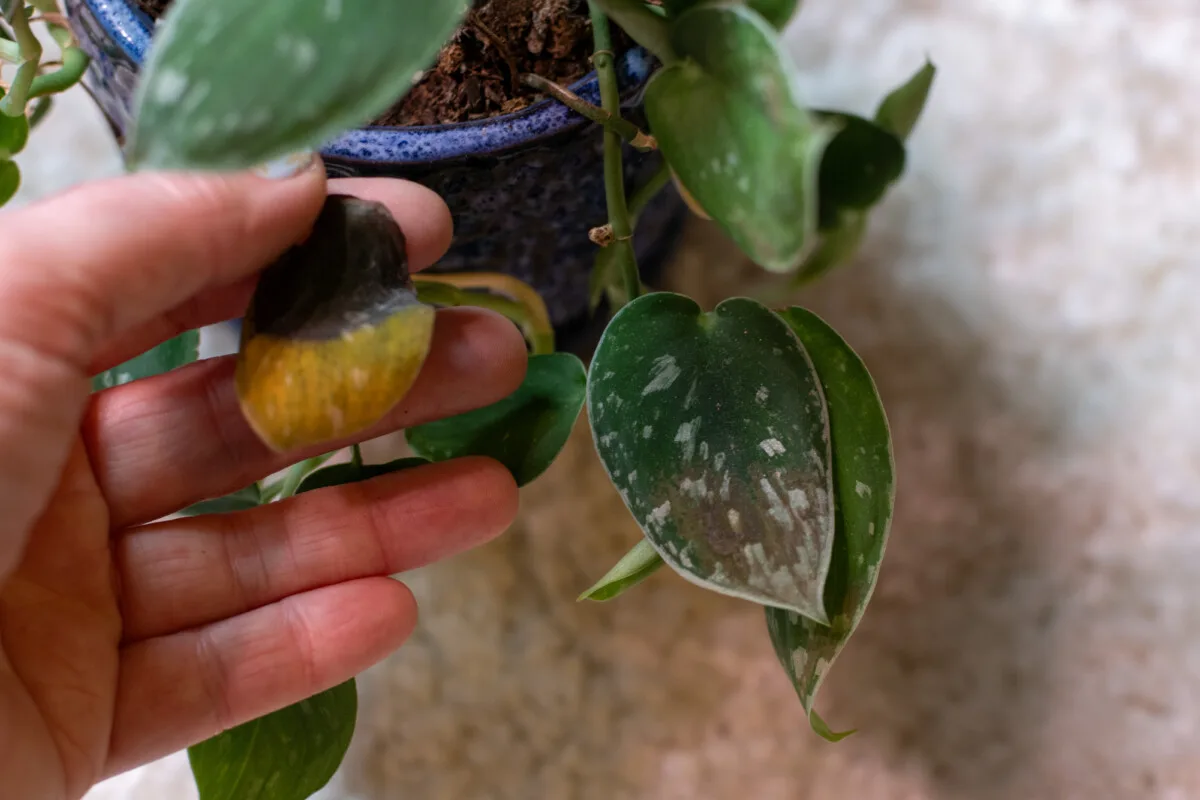
Satin pothos with chilly harm from being close to a drafty window for too lengthy.
For barely extra critical circumstances, you possibly can isolate the harm and prune off broken leaves, permitting the remainder of the plant to recuperate.
If you happen to assume it’s a misplaced trigger, examine the foundation ball, as this would be the most informative technique to see if the plant nonetheless has a preventing likelihood.
And should you do find yourself shedding a houseplant or two to the winter months? Effectively, that simply means you’ve obtained a spare pot that wants filling within the spring!

Get the well-known Rural Sprout publication delivered to your inbox.
Together with Sunday ramblings from our editor, Tracey, in addition to “What’s Up Wednesday” our roundup of what’s in season and new article updates and alerts.
